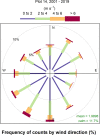Two decades of fumigation data from the Soybean Free Air Concentration Enrichment facility
- PMID: 37081032
- PMCID: PMC10119297
- DOI: 10.1038/s41597-023-02118-x
Two decades of fumigation data from the Soybean Free Air Concentration Enrichment facility
Abstract
The Soybean Free Air Concentration Enrichment (SoyFACE) facility is the longest running open-air carbon dioxide and ozone enrichment facility in the world. For over two decades, soybean, maize, and other crops have been exposed to the elevated carbon dioxide and ozone concentrations anticipated for late this century. The facility, located in East Central Illinois, USA, exposes crops to different atmospheric concentrations in replicated octagonal ~280 m2 Free Air Concentration Enrichment (FACE) treatment plots. Each FACE plot is paired with an untreated control (ambient) plot. The experiment provides important ground truth data for predicting future crop productivity. Fumigation data from SoyFACE were collected every four seconds throughout each growing season for over two decades. Here, we organize, quality control, and collate 20 years of data to facilitate trend analysis and crop modeling efforts. This paper provides the rationale for and a description of the SoyFACE experiments, along with a summary of the fumigation data and collation process, weather and ambient data collection procedures, and explanations of air pollution metrics and calculations.
© 2023. This is a U.S. Government work and not under copyright protection in the US; foreign copyright protection may apply.
Conflict of interest statement
The authors declare no competing interests.
Figures



Similar articles
-
Using leaf optical properties to detect ozone effects on foliar biochemistry.Photosynth Res. 2014 Feb;119(1-2):65-76. doi: 10.1007/s11120-013-9837-y. Epub 2013 May 9. Photosynth Res. 2014. PMID: 23657827
-
Future carbon dioxide concentration decreases canopy evapotranspiration and soil water depletion by field-grown maize.Glob Chang Biol. 2013 May;19(5):1572-84. doi: 10.1111/gcb.12155. Epub 2013 Mar 5. Glob Chang Biol. 2013. PMID: 23505040
-
Decomposition analysis on soybean productivity increase under elevated CO2 using 3-D canopy model reveals synergestic effects of CO2 and light in photosynthesis.Ann Bot. 2020 Sep 14;126(4):601-614. doi: 10.1093/aob/mcz163. Ann Bot. 2020. PMID: 31638642 Free PMC article.
-
30 years of free-air carbon dioxide enrichment (FACE): What have we learned about future crop productivity and its potential for adaptation?Glob Chang Biol. 2021 Jan;27(1):27-49. doi: 10.1111/gcb.15375. Epub 2020 Nov 2. Glob Chang Biol. 2021. PMID: 33135850 Review.
-
Approaches to investigate crop responses to ozone pollution: from O3 -FACE to satellite-enabled modeling.Plant J. 2022 Jan;109(2):432-446. doi: 10.1111/tpj.15501. Epub 2021 Oct 8. Plant J. 2022. PMID: 34555243 Free PMC article. Review.
Cited by
-
Crops and rising atmospheric CO2: friends or foes?Philos Trans R Soc Lond B Biol Sci. 2025 May 29;380(1927):20240230. doi: 10.1098/rstb.2024.0230. Epub 2025 May 29. Philos Trans R Soc Lond B Biol Sci. 2025. PMID: 40439307 Free PMC article. Review.
-
Manipulating atmospheric CO2 concentration induces shifts in wheat leaf and spike microbiomes and in Fusarium pathogen communities.Front Microbiol. 2023 Oct 10;14:1271219. doi: 10.3389/fmicb.2023.1271219. eCollection 2023. Front Microbiol. 2023. PMID: 37881249 Free PMC article.
-
Similar photosynthetic but different yield responses of C3 and C4 crops to elevated O3.Proc Natl Acad Sci U S A. 2023 Nov 14;120(46):e2313591120. doi: 10.1073/pnas.2313591120. Epub 2023 Nov 10. Proc Natl Acad Sci U S A. 2023. PMID: 37948586 Free PMC article.
-
Nitrogen fertilization form and energetic status as target points conditioning rice responsiveness to elevated [CO2].Front Plant Sci. 2025 Mar 11;16:1517360. doi: 10.3389/fpls.2025.1517360. eCollection 2025. Front Plant Sci. 2025. PMID: 40134626 Free PMC article.
References
Publication types
Grants and funding
- DE-FG02-04ER63849/U.S. Department of Energy (DOE)
- DE-FC02-06ER64158/U.S. Department of Energy (DOE)
- DE-SC0018420/U.S. Department of Energy (DOE)
- 2002-02723/U.S. Department of Agriculture (United States Department of Agriculture)
- 2010-65114-20343/United States Department of Agriculture | National Institute of Food and Agriculture (NIFA)
- 2010-65114-20355/United States Department of Agriculture | National Institute of Food and Agriculture (NIFA)
- 2014-67013-21783/United States Department of Agriculture | National Institute of Food and Agriculture (NIFA)
- 2015-67013-22836/United States Department of Agriculture | National Institute of Food and Agriculture (NIFA)
- IBN 0236053/National Science Foundation (NSF)
- PGR-1238030/National Science Foundation (NSF)
LinkOut - more resources
Full Text Sources

